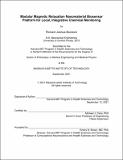Modular Magnetic Relaxation Nanomaterial Biosensor Platform for Local, Integrative Chemical Monitoring
Author(s)
Murdock, Richard Joshua
DownloadThesis PDF (75.18Mb)
Advisor
Cima, Michael J.
Terms of use
Metadata
Show full item recordAbstract
There is a large gap in the diagnostic tools available to the clinical world today. Current sporadic health data points are only snapshots of a larger picture of disease in populations whose conditions change with time. The objective of this work is to develop an implantable diagnostic medical device platform for the tracking of temporally-varying disease chemical biomarkers. Continuous measurement of critical biomarkers provides a fuller understanding of physiology in response to stimulus, stress, or episodic and acute events. Classification of patient phenotype can be based on the timeline and level of biomarker elevation, persistence, and remission following these stimuli. Chronic disease surveillance in particular requires stable, long term in vivo sensors to realize such measurements. Current limitations in signal stability and inefficient transduction from opaque, heterogeneous biological environments hamper clinical implementation of biosensor technologies. Cumulative exposure, colloidal nanoparticle, magnetic relaxometry assays coupled with single-sided NMR relaxometry for clinic and point-ofcare, resource-limited settings are a promising technology for in vivo biosensing. Through a multidimensional combination of nanotechnology, diagnostic device development, magnetic relaxation physics, and hydrogel biomaterial diffusion membrane design, this dissertation endeavors to improve the diagnostic armamentarium of modular diagnostic biosensors available to the medical community.
Multicomponent populations of layered particles were designed to stably measure the presence of clinically-relevant biomolecules over months. Reading the irreversible interaction of these particles with the biochemical markers they are tuned against by magnetic relaxation allows for wireless, non-invasive measurement providing insight into real-time results over varying timescales. Here we show that by fundamental advancements in the exploration of nanomaterial properties, chemical conjugation strategies, and device engineering parameters, the kinetic and signal amplitude performance of a switch-based dosimeter can be substantially improved. The simultaneous investigation of device search and data extraction methods for implanted devices and the characterization of hydrogel material diffusion barriers also serves to advance the translation of magnetic relaxation biosensors beyond a benchtop system toward a clinically relevant, implantable platform technology. The implications of this work will help guide the personalized medicine campaign in biosensing and provide valuable insights into the next generation of diagnostic management of chronic disease.
Date issued
2021-09Department
Harvard-MIT Program in Health Sciences and TechnologyPublisher
Massachusetts Institute of Technology